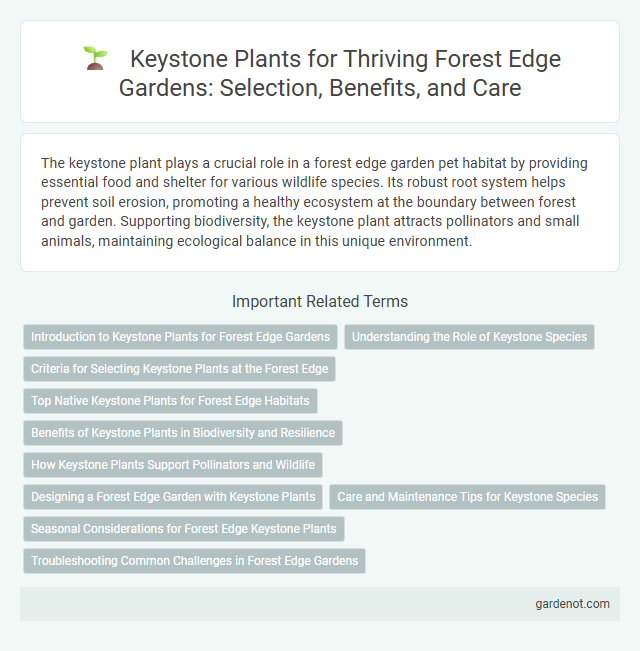The keystone plant plays a crucial role in a forest edge garden pet habitat by providing essential food and shelter for various wildlife species. Its robust root system helps prevent soil erosion, promoting a healthy ecosystem at the boundary between forest and garden. Supporting biodiversity, the keystone plant attracts pollinators and small animals, maintaining ecological balance in this unique environment.
Introduction to Keystone Plants for Forest Edge Gardens
Keystone plants in forest edge gardens play a crucial role in maintaining ecosystem stability by supporting diverse wildlife and promoting soil health. These plants provide habitat, food, and shelter for pollinators, birds, and small mammals, enhancing biodiversity along transitional forest boundaries. Selecting native keystone species such as oaks, witch hazel, and spicebush ensures resilience and balanced nutrient cycling in forest edge environments.
Understanding the Role of Keystone Species
Keystone plants in a forest edge garden play a critical role in maintaining ecosystem stability by supporting diverse wildlife and enhancing habitat complexity. These species facilitate nutrient cycling, provide essential food sources, and create microhabitats that sustain pollinators, birds, and small mammals. Understanding the ecological functions of keystone plants helps optimize biodiversity and resilience at the forest edge interface.
Criteria for Selecting Keystone Plants at the Forest Edge
Keystone plants at the forest edge are selected based on their ability to support biodiversity, provide essential wildlife habitat, and maintain ecological balance. Criteria include resilience to edge disturbances, capacity to fix nitrogen or enhance soil quality, and provision of food or shelter for keystone animal species such as pollinators and seed dispersers. Selecting native species that promote symbiotic relationships and adapt to fluctuating light and moisture conditions ensures the stability and health of the forest edge ecosystem.
Top Native Keystone Plants for Forest Edge Habitats
Top native keystone plants in forest edge habitats include oak (Quercus spp.), black cherry (Prunus serotina), and American hazelnut (Corylus americana). These species provide critical resources such as food and shelter for diverse wildlife, supporting birds, mammals, and pollinators essential to ecosystem stability. Their presence enhances soil health and promotes biodiversity, making them indispensable for sustainable forest edge garden management.
Benefits of Keystone Plants in Biodiversity and Resilience
Keystone plants in forest edge gardens play a crucial role in maintaining biodiversity by providing essential habitat and food sources for a wide range of wildlife species. Their presence enhances ecosystem resilience by stabilizing soil, supporting pollinators, and facilitating nutrient cycling, which helps the garden adapt to environmental stressors. These plants act as ecological anchors, promoting a balanced and thriving forest edge environment.
How Keystone Plants Support Pollinators and Wildlife
Keystone plants in forest edge gardens provide essential nectar, pollen, and habitat for a diverse array of pollinators such as bees, butterflies, and hummingbirds, supporting their lifecycle and promoting biodiversity. These plants enhance ecosystem stability by attracting beneficial insects that aid in pollination and pest control, contributing to the overall health of the garden. Wildlife, including birds and small mammals, benefit from the food resources and shelter keystone plants offer, facilitating a balanced and thriving ecological community.
Designing a Forest Edge Garden with Keystone Plants
In designing a forest edge garden, selecting keystone plants such as oaks (Quercus spp.) or serviceberries (Amelanchier spp.) enhances biodiversity by providing critical food and habitat resources for wildlife. These plants create a dynamic ecological interface, supporting pollinators, birds, and beneficial insects while stabilizing soil and improving microclimatic conditions. Integrating keystone species strategically maximizes ecosystem resilience and promotes sustainable growth at the forest boundary.
Care and Maintenance Tips for Keystone Species
Keystone plants in forest edge gardens require consistent soil moisture and well-drained soil to thrive, ensuring their vital role in supporting local ecosystems. Regular pruning of dead or damaged branches promotes healthy growth and maximizes habitat provision for pollinators and wildlife. Monitoring for pests and diseases early allows for targeted, eco-friendly treatments that maintain plant vigor and preserve biodiversity.
Seasonal Considerations for Forest Edge Keystone Plants
Keystone plants at the forest edge require careful attention to seasonal changes to thrive and support local biodiversity. During spring, these plants benefit from increased moisture and moderate temperatures, which promote vigorous growth and flowering. In autumn, their ability to withstand temperature fluctuations and prepare for dormancy ensures resilience and a continued role in ecosystem stability.
Troubleshooting Common Challenges in Forest Edge Gardens
Keystone plants in forest edge gardens often face challenges such as soil erosion, pest infestations, and competition from invasive species. Implementing soil stabilization techniques, integrated pest management, and regular monitoring can mitigate these issues effectively. Promoting biodiversity around keystone plants enhances resilience and supports ecosystem balance at the forest edge.
Keystone plant Infographic

 gardenot.com
gardenot.com